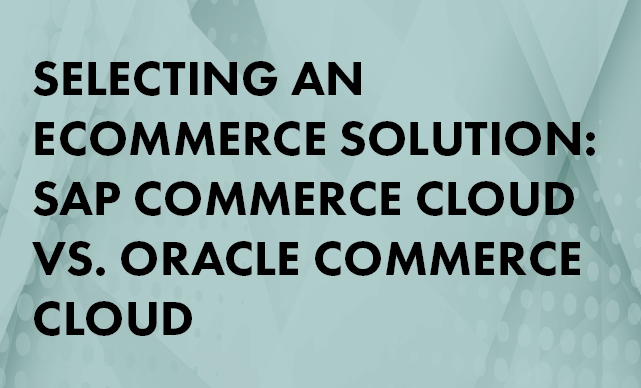Stay Relevant in a Volatile Business Environment with SAP Commerce Cloud
by Bahaa Badran, Global Vice President, Cloud MOVE, SAP Customer Experience Services, SAP
Organizations are constantly seeking ways to stay relevant in the ever-changing landscape of digital commerce. Those with on-premise deployments of digital commerce solutions can face significant obstacles in this pursuit. These on-premise deployments age quickly, and as their functionality becomes obsolete, they can leave consumers with a suboptimal shopping experience they might not forget. Adding new functionality via custom code is also no panacea, as it invariably leads to greater complexity along with creeping development and maintenance costs.
Explore related questions
So, with all this in mind, where do SAP customers go from here? How do you select the right digital commerce deployment and keep driving the revenue your business needs to avoid falling behind — or out of the race entirely? And even more important, how do you keep your business moving forward in crisis situations, such as the one we are facing with COVID-19?
With cloud deployments of solutions, new functionality is released continuously — and so are new security features. In times of crisis, cloud deployments allow valuable flexibility for ongoing maintenance, development, and servicing: most work on the platform can be done remotely and very effectively. When it comes to digital commerce, SAP Commerce Cloud offers a path forward. But how do you move your current on-premise platform to the cloud without jeopardizing your revenue stream?
Put the Right Planning in Place
Moving to the cloud does not have to be a headache — it can be a smooth process with the proper planning and support from an experienced provider. A cloud migration certainly can be a complex project, especially if your on-premise SAP Commerce instance is an older or heavily customized version, but this increased complexity simply means you need to more meticulously plan for the move — nothing more.
The complexity of the project will depend on many factors. These include the level of existing customizations, whether you leverage a content delivery network (CDN) solution to help with availability and performance or use external web acceleration tools, the search engine you use, and whether you use third-party software with complex integrations.
It is important to keep in mind that SAP Commerce Cloud does not support all versions of the SAP Commerce runtime, so for customers on non-compatible versions, an upgrade may be required before moving to the cloud. This is not a bad thing, however — this is an opportunity to assess the existing customizations, lighten the code, reassess your solution architecture, and identify to what extent your code base and infrastructure setup vary from recommended practices.
You Don’t Have to Do It Alone
Your cloud migration project will likely involve multiple parties: your team, a systems integrator or partner, and possibly SAP. A carefully considered split of responsibilities and orchestration of tasks is required, and SAP can provide a valuable point of view on the recommended division of tasks and best practices for the project.
SAP provides many resources, including some at no charge, to help you with scoping, planning, and executing SAP Commerce Cloud migration projects. CX Works, the SAP Customer Experience online knowledge platform, is a portal that contains free expert recommendations and guidance for evaluating, implementing, and getting the most value from the SAP Customer Experience solutions. Another resource is the SAP Customer Experience Services team, which offers specialized services ranging from effort and feasibility assessments all the way to full project execution.
And for those who are thinking of getting started, but are not sure where to begin, SAP’s services along with educational webinars that explore these topics in depth can serve as a starting point to help you make the right decision for your organization.

Bahaa Badran is Global Vice President, Cloud MOVE, SAP Customer Experience Services at SAP. His team is focused on helping clients achieve digital e-commerce transformation by tapping into all its components: strategy, data integration, process alignment, project execution, technology, and enablement. Badran specializes in SAP Commerce Cloud deployments and helping SAP clients resolve their challenges with aging on-premise installations.







